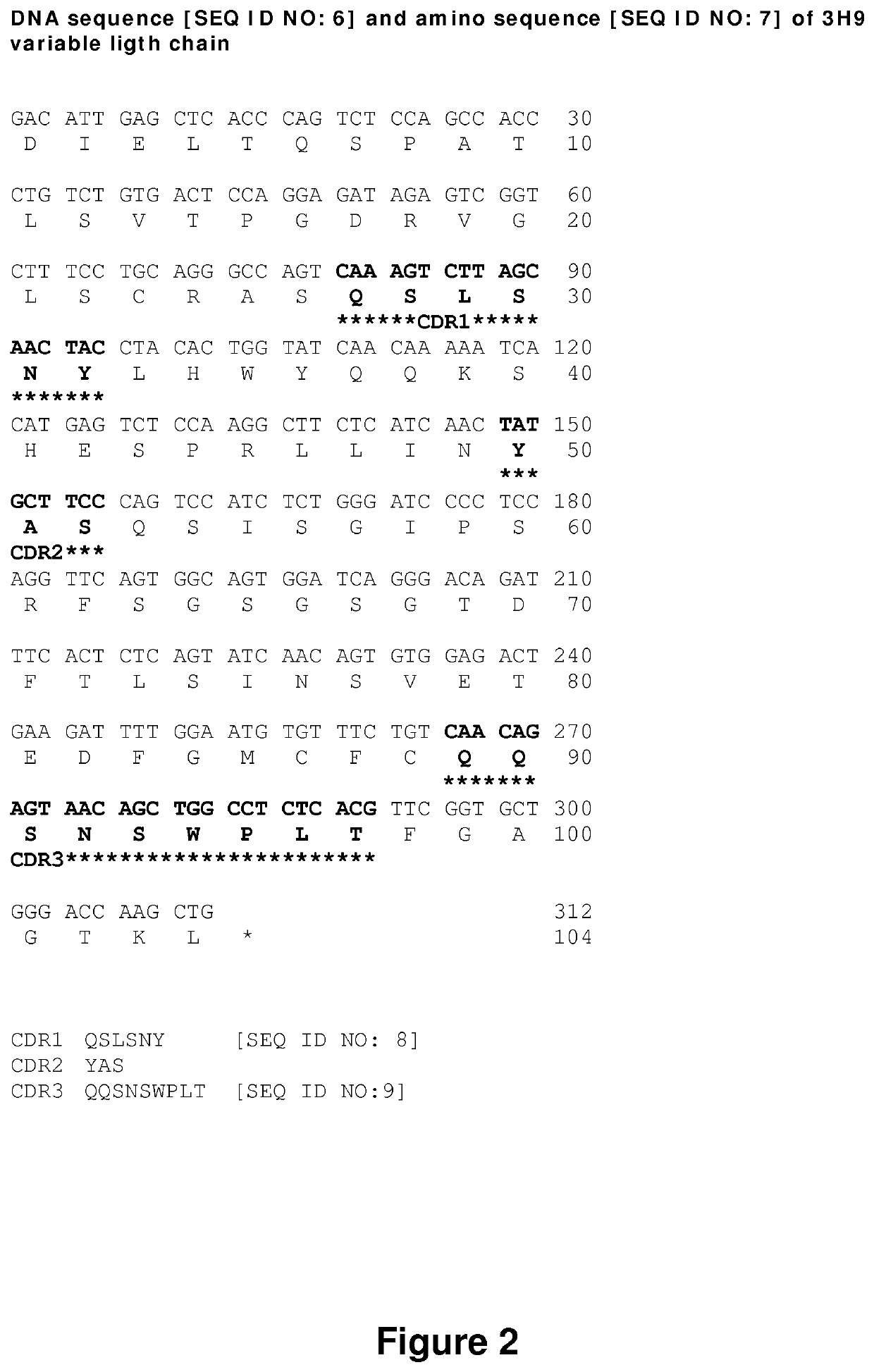Haemorrhagic disorder due to ventricular assist device
a technology of ventricular assist device and haemorrhagic disorder, which is applied in the direction of antibody medical ingredients, drug compositions, extracellular fluid disorders, etc., can solve the problems of life-threatening clinical complications, and achieve the effect of enhancing the clearance of vwf and increasing the siz
- Summary
- Abstract
- Description
- Claims
- Application Information
AI Technical Summary
Benefits of technology
Problems solved by technology
Method used
Image
Examples
example 1
ctivity of the Anti-ADAMTS13 Monoclonal Antibody Ab11316CB with ADAMTS13 of Sheep and Pigs
[0239]The ADAMTS13 activity in plasma was determined with the use of a FRETS-VWF73 assay (Kokame et al., Br J Haematol., 129: 93-100 (2005)). The activity of ADAMTS13 in sheep plasma (SP) was compared with the activity in normal human plasma (NHP) and pig serum. Next, also the antibody Ab11316CB (100 μg / ml) was added. The activity of ADAMTS13 in different plasmas and sera was determined via NHP, in which the activity was set at 100%.
[0240]The anti-ADAMTS13 antibody Ab11316CB is capable of inhibiting the activity of ADAMTS13 present in NHP and pig serum, but Ab11316CB cannot inhibit the activity of ADAMTS13 in sheep plasma. As a control inhibitor EDTA (a chelator of Zn2+ and Ca2±, which are necessary for the activity of ADAMTS13) was added, which could inhibit the ADAMTS13 activity in sheep plasma (FIG. 5).
example 2
ADAMTS13 Activity Protects Against Loss of HMW VWF Multimers in an In Vitro LVAD System
[0241]The inhibiting anti-ADAMTS13 antibody Ab11316CB is used to block ADAMTS13 activity. The non-functional anti-ADAMTS13 antibody 5C11 was used as a control. Different doses (1 μg / ml, 4 μg / ml and 20 μg / ml) of the antibody Ab11316CB (inhibiting ADAMTS13 activity) or 5C11 (negative control antibody with no functional effect on ADAMTS13) were added to full blood and used in an in vitro LVAD pump. Blood samples were taken before (TO) and after 5, 30 and 180 minutes to determine the multimer distribution. The plasma samples were loaded on a 0.8% stacking and 1.2% running agarosegel. After running the gel, the gel was dried and incubated with an alkaline phosphatase labelled anti-human VWF antibody. Next, a colour reaction was performed to visualize the multimer pattern (FIG. 6).
[0242]To calculate the percentage of the low molecular weight (LMW) VWF, middle molecular weight (MMW) VWF and high molecula...
example 3
ization of 17C7 and Human Plasma
[0244]Monoclonal Anti-ADAMTS13 Antibody 17C7 Captures Human ADAMTS13 from Human Plasma.
[0245]A 96-well plate was coated with 17C7 or 3H9 (Ab11316CB) (5 μg / mL), blocked and a serial dilution of normal human plasma (NHP) or plasma of a congenital TTP patient was added (15% in first well, 1.5 / 2.5 dilution). Bound ADAMTS13 was detected with in house developed biotinylated monoclonal anti-ADAMTS13 antibodies 17G2 and 19H4 (1.5 μg / mL) followed by addition of streptavidin labelled with horse radish peroxidase (HRP). Colouring reaction was performed with orthophenylene diamine (OPD) and H2O2. The reaction was stopped with H2504. Data are represented as mean+ / −SD, n=3.
[0246]When coating a constant concentration of 17C7 or 3H9 (Ab11316CB) and adding a dilution series of normal human plasma, both monoclonal anti-ADAMTS13 antibodies 17C7 and 3H9 (Ab11316CB) efficiently capture human ADAMTS13 from human plasma (FIG. 8).
[0247]Monoclonal Anti-ADAMTS13 Antibody 17C7 ...
PUM
| Property | Measurement | Unit |
|---|---|---|
| dissociation constant | aaaaa | aaaaa |
| dissociation constant | aaaaa | aaaaa |
| dissociation constant | aaaaa | aaaaa |
Abstract
Description
Claims
Application Information
 Login to View More
Login to View More - R&D
- Intellectual Property
- Life Sciences
- Materials
- Tech Scout
- Unparalleled Data Quality
- Higher Quality Content
- 60% Fewer Hallucinations
Browse by: Latest US Patents, China's latest patents, Technical Efficacy Thesaurus, Application Domain, Technology Topic, Popular Technical Reports.
© 2025 PatSnap. All rights reserved.Legal|Privacy policy|Modern Slavery Act Transparency Statement|Sitemap|About US| Contact US: help@patsnap.com



